North Carolina, a birdwatcher’s paradise, is home to a variety of beautiful blue birds that grace its skies and forests. From the well-loved Eastern Bluebird to the elusive Blue Grosbeak, the state hosts an impressive list of 13 different blue-colored birds. In this guide, we will explore each of these stunning creatures, providing detailed information on their appearance, habitats, and behaviors.
Plus, with our Free Photo Guide, you’ll have a visual companion to help you identify and appreciate these winged wonders even more. Get ready to embark on a journey through the diverse world of North Carolina’s blue birds!
Blue Birds Found In North Carolina
The diverse geography of North Carolina, ranging from its coastal plains to mountainous regions, creates a variety of habitats that support a wide range of bird species. The state’s vast forests, wetlands, and coastline provide ideal environments for nesting and migratory birds. Furthermore, the mild climate and abundant food sources attract a multitude of bird species, making it a hotspot for birdwatchers and nature enthusiasts alike.
This combination of varied habitats and climates makes North Carolina home to a rich and diverse bird population, including an array of beautiful blue birds.
Blue Jay

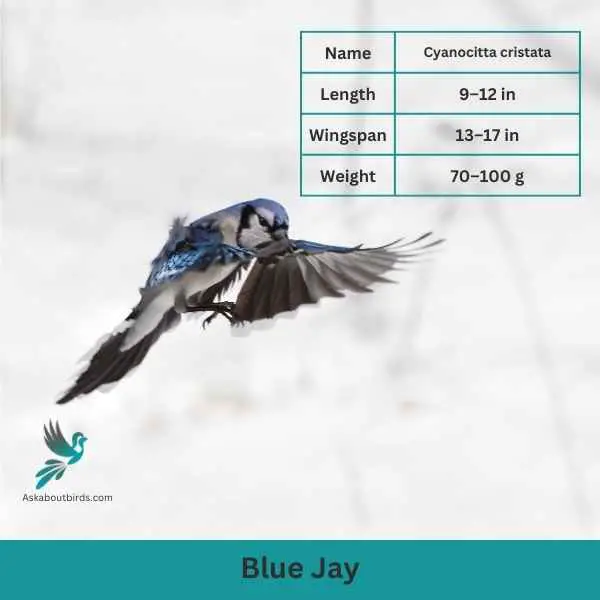
| Feature | Measurement |
|---|---|
| Scientific Name | Cyanocitta cristata |
| Length | 9–12 in |
| Wingspan | 13–17 in |
| Weight | 70–100 g |
The Blue Jay is a vibrant and easily recognized bird, known for its intelligence, distinctive calls, and bold behavior, commonly found throughout the eastern and central United States.
Appearance: The Blue Jay sports a striking blue upper body with white and black markings. Its face has a pronounced white patch with a black necklace that runs across the throat and around the head. The bird also features a pronounced blue crest, which can be raised or lowered, and its wings and tail are brightly colored with black bars and white tips.
Diet: Blue Jays are omnivores. Their diet consists primarily of seeds, nuts, especially acorns, fruits, and small insects. They’ve also been known to eat eggs or nestlings of other birds occasionally. Blue Jays often store food items in caches to eat later.
Reproduction: Blue Jays are monogamous birds that form long-lasting pair bonds. They typically build their nests in trees or large shrubs, constructing them from twigs, grass, and sometimes using mud as a binder. The female lays a clutch of 3 to 6 eggs, which are pale blue or sometimes white with brown speckles.
Belted Kingfisher

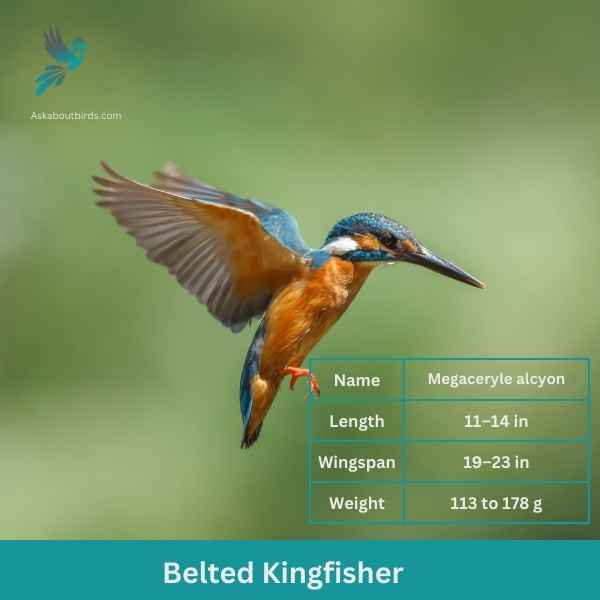
| Feature | Measurement |
|---|---|
| Scientific Name | Megaceryle alcyon |
| Length | 11–14 in |
| Wingspan | 19–23 in |
| Weight | 113 to 178 g |
The Belted Kingfisher is a distinctive and easily recognizable bird, frequently observed near water bodies, where it can be seen diving headfirst to catch prey.
Appearance: Sporting a prominent crest, the Belted Kingfisher has a slate blue-gray upper body and white underparts. Males possess a single blue band across their white chests, while females have an additional rufous band, making them one of the few bird species where females are more brightly colored than males. Their bill is long, sharp, and dagger-like.
Diet: As expert fishers, Belted Kingfishers mainly prey on small fish, but they’ll also consume crustaceans, insects, and amphibians. They’re known for their hunting tactic of hovering over water, spotting their prey, and then diving swiftly to snatch it.
Reproduction: Belted Kingfishers nest in burrows which they excavate in sandy or earthen banks, usually adjacent to water. The tunnel can be anywhere from 3 to 6 feet long, ending in a chamber. Within this chamber, the female lays a clutch of 5 to 8 white eggs.
Indigo Bunting


| Feature | Measurement |
|---|---|
| Scientific Name | Passerina cyanea |
| Length | 4.5–5.1 in |
| Wingspan | 7.1–9.1 in |
| Weight | 11.2–21.4 g |
The Indigo Bunting is a strikingly vibrant songbird, often hailed for its brilliant blue plumage and melodic song that graces woodlands and meadows during the warmer months.
Appearance: Males are renowned for their bright indigo blue feathers, which can appear darker in certain lights. Females and juveniles, on the other hand, are brown with subtle hints of blue on their wings and tail. The species lacks the vibrant streaking or spotting commonly found in many other songbirds.
Diet: Indigo Buntings primarily subsist on seeds, especially during non-breeding seasons. During the breeding season, they also consume a variety of insects such as beetles, caterpillars, and spiders, providing essential protein for their growing chicks.
Reproduction: Indigo Buntings build their nests close to the ground in shrubs or low tree branches. These nests, crafted meticulously with grasses and other plant materials, cradle clutches of typically 3 to 4 eggs. After hatching, the young are fed by both parents until they’re ready to fledge.
Purple Martin
Cerulean Warbler
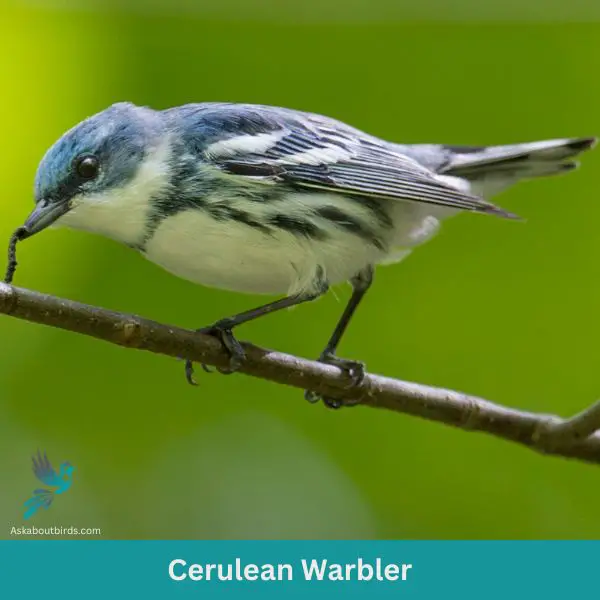
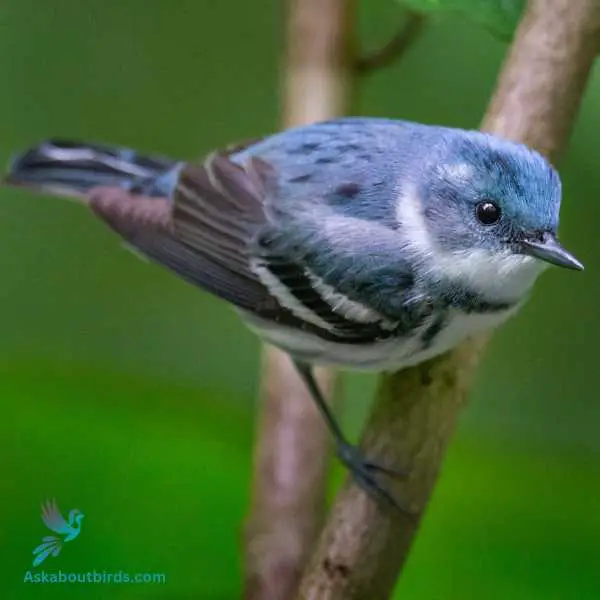
| Trait | Cerulean Warbler |
|---|---|
| Scientific Name | Setophaga cerulea |
| Length | 4.5 inches |
| Wingspan | 7.9-8.7 inches |
| Weight | 0.3-0.4 ounces |
The Cerulean Warbler is a striking songbird known for its sky-blue plumage and flitting movements in the forest canopy.
Appearance: Males boast a vibrant cerulean blue color on their upperparts, with streaked underparts, and a black necklace. Females have a more subdued bluish-green hue and lack the prominent black markings seen in males.
Diet: The diet of the Cerulean Warbler is predominantly made up of insects and spiders. They actively forage high in the treetops, gracefully maneuvering through leaves and branches.
Reproduction: Cerulean Warblers nest in the upper branches of tall deciduous trees. The female weaves a shallow cup-shaped nest and lays a clutch of 3-5 eggs.
Eastern Bluebird
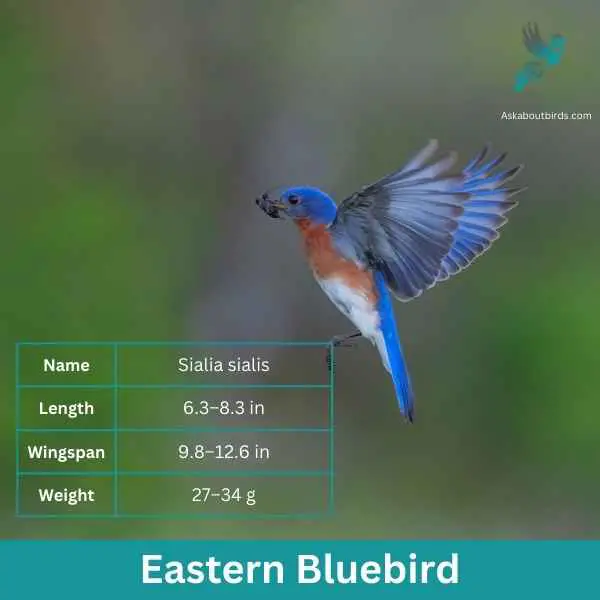
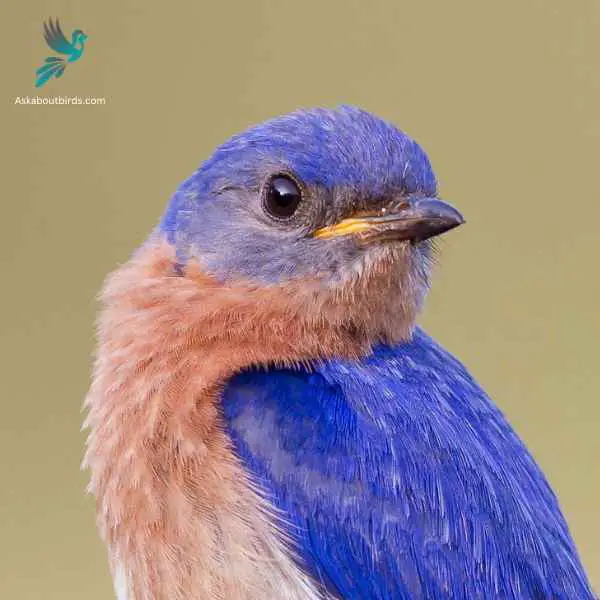
| Feature | Measurement |
|---|---|
| Scientific Name | Sialia sialis |
| Length | 6.3–8.3 in |
| Wingspan | 9.8–12.6 in |
| Weight | 27–34 g |
The Eastern Bluebird (Sialia sialis) is a small thrush found in open woodlands, farmlands, and orchards, and is recognized for its vibrant blue and red coloration. Male Eastern Bluebirds are dazzling with bright blue upperparts and a rusty or brick-red throat and breast, while females, though less colorful, still offer a similar pattern. The bird is native to North America and is commonly seen east of the Rockies, from Canada to the Gulf States and southeastern Arizona to Nicaragua.
Eastern Bluebirds feed on insects, wild fruit and berries. They have a gentle nature and are often seen perched alone or in small groups in the open, scanning the ground for prey. They are cavity nesters and will use old woodpecker holes or birdhouses if they are the right size.
Mountain Bluebird
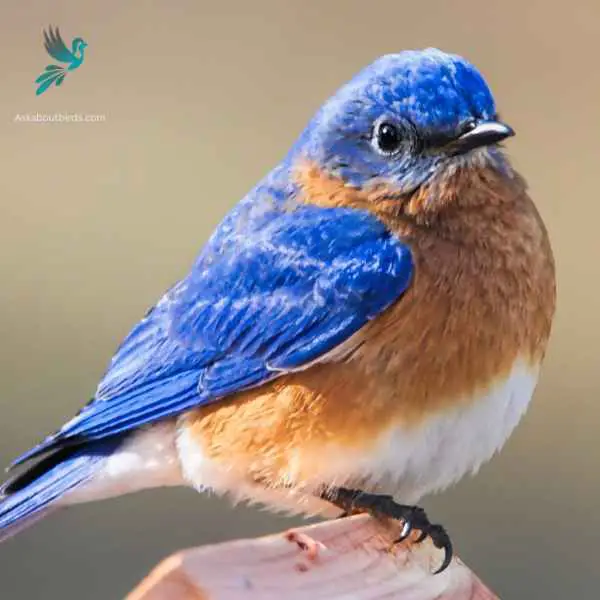
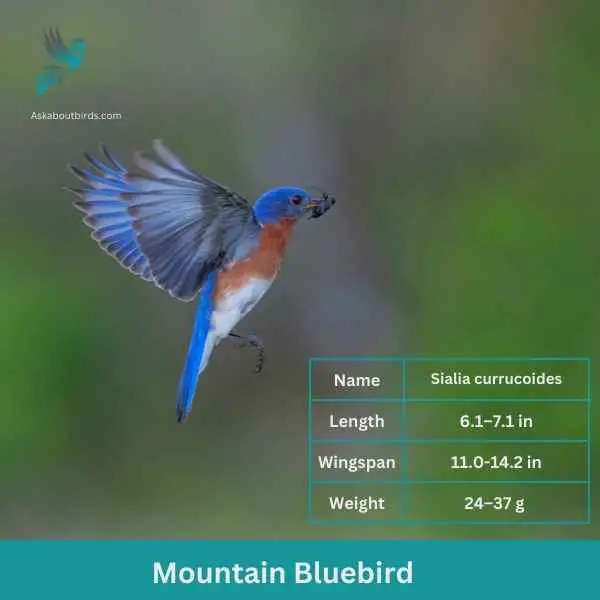
| Feature | Measurement |
|---|---|
| Scientific Name | Sialia currucoides |
| Length | 6.1–7.1 in |
| Wingspan | 11.0-14.2 in |
| Weight | 24–37 g |
The Mountain Bluebird is a small bird found in open grasslands and rocky mountains of North America. It is known for its stunning blue plumage, which is particularly vibrant in males. Females, on the other hand, have a more subdued blue coloration with hints of gray. These birds have slender bodies and a slightly curved bill, adapted for catching insects on the wing.
Mountain Bluebirds are insectivores, feeding primarily on insects such as beetles, grasshoppers, and spiders. They are skilled aerial hunters, capable of capturing their prey in mid-flight. During breeding season, these birds build their nests in tree cavities or man-made nest boxes, where females lay a clutch of eggs. The male bluebird actively participates in nest-building and provides food for the female during incubation.
Western Bluebird
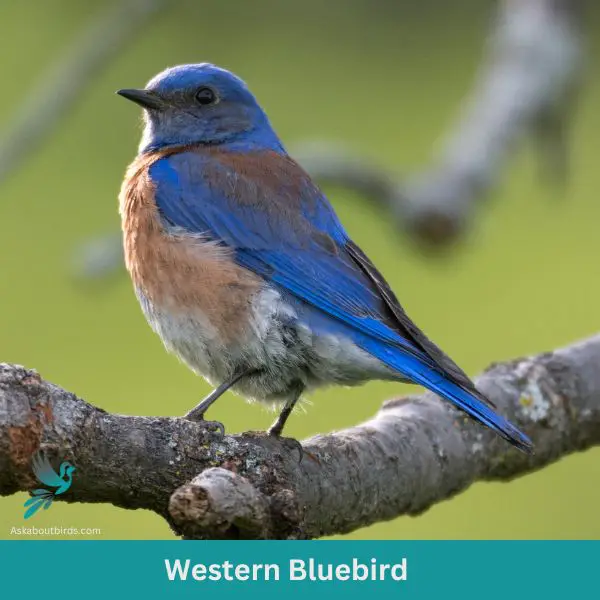
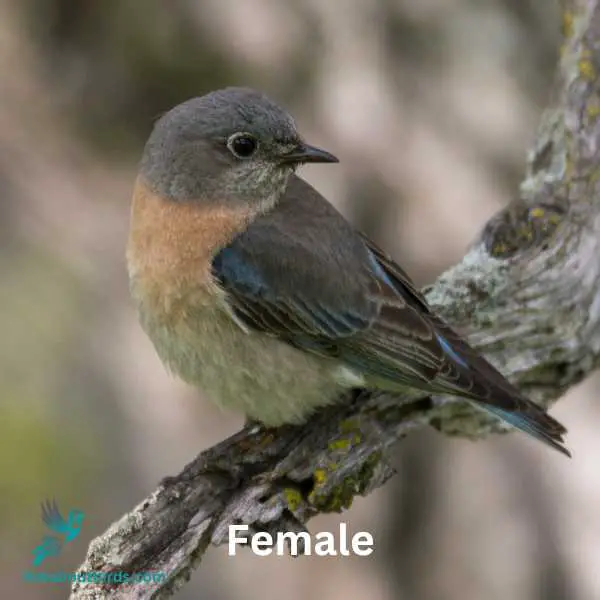
| Trait | Western Bluebird |
|---|---|
| Scientific Name | Sialia mexicana |
| Length | 5.5-7 inches |
| Wingspan | 11-13 inches |
| Weight | 0.8-1.1 ounces |
The Western Bluebird is a charismatic bird, appreciated for its vivid coloring and melodious song, commonly observed in open woodlands and meadows of the West.
Appearance: The male Western Bluebird sports a dark blue head, throat, wings, and tail with an orange breast and sides, transitioning into a grayish belly. Females are more muted, displaying grayish-blue wings and tail with a more subdued orange wash on the chest.
Diet: Western Bluebirds predominantly feed on insects, complemented by berries and fruits when available. They hunt by perching and then diving to the ground to capture their prey, and they’re also known to catch insects in mid-air.
Reproduction: These birds often utilize natural tree cavities or nest boxes for breeding. The female builds a loose nest inside and lays a clutch of 4-6 pale blue eggs.
Blue Grosbeak
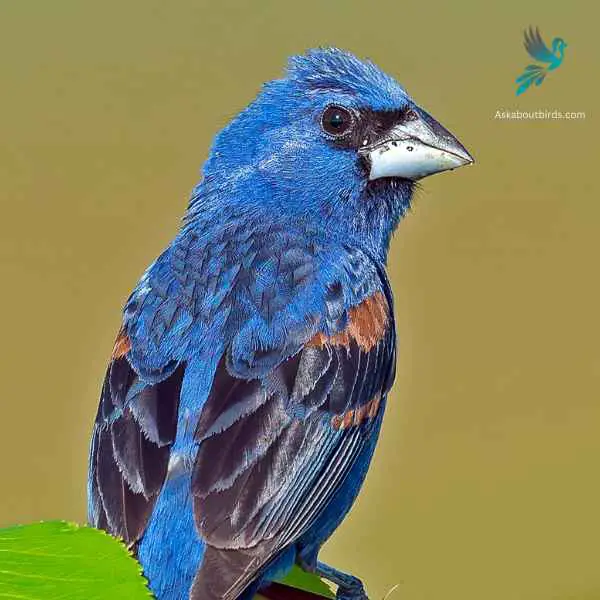

| Feature | Measurement |
|---|---|
| Scientific Name | Passerina caerulea |
| Length | 5.5 to 7.5 in |
| Wingspan | 10 to 11 in |
| Weight | 26 to 31.5 g |
The Blue Grosbeak is a medium-sized songbird found in North and Central America. The male Blue Grosbeak displays stunning plumage with deep blue feathers on its body and head, while the female has more subdued brownish tones. Both sexes have a thick, conical bill, which gives them their name “grosbeak,” meaning large beak.
These birds prefer open habitats such as grasslands, brushy areas, and woodland edges. Blue Grosbeaks are known for their melodious songs, which consist of a series of rich and varied notes. They primarily feed on seeds and insects, using their strong beaks to crack open seeds and forage on the ground or in low vegetation.
Florida Scrub-Jay
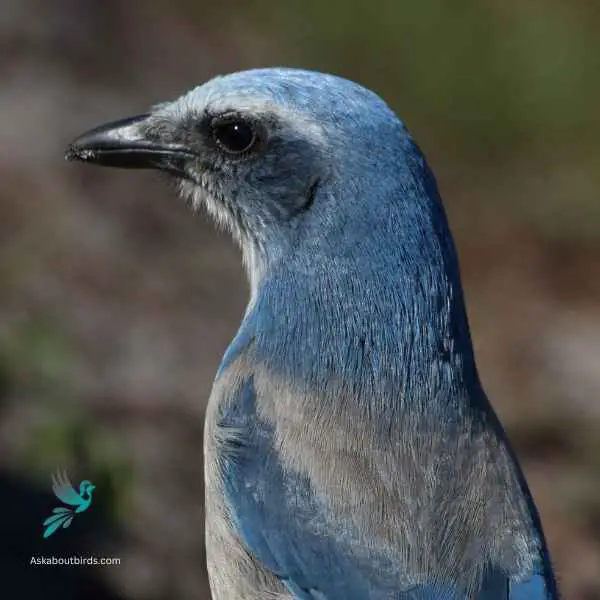
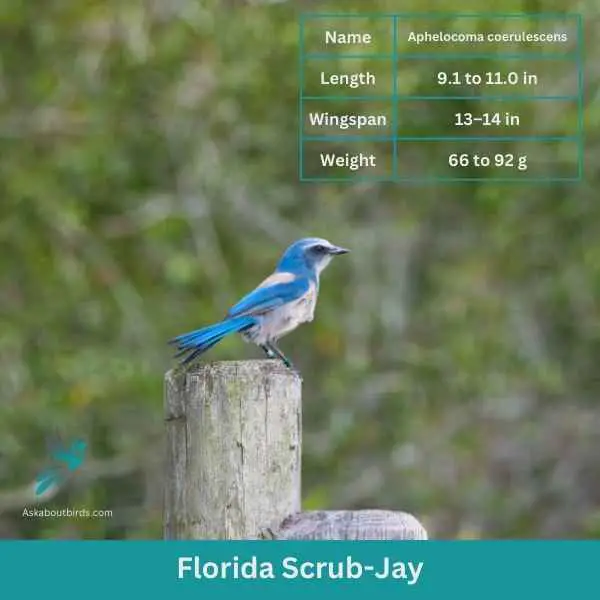
| Feature | Measurement |
|---|---|
| Scientific Name | Aphelocoma coerulescens |
| Length | 9.1 to 11.0 in |
| Wingspan | 13–14 in |
| Weight | 66 to 92 g |
The Florida Scrub-Jay is a striking, cooperative-breeding bird endemic to the sandy scrublands of Florida. It stands out as the only species of bird restricted entirely to the state of Florida.
Appearance: The Florida Scrub-Jay exhibits a bright blue head, wings, and tail, contrasting with its pale gray underbelly and nape. Its stout bill, legs, and eyes are black. Unlike other jays, it lacks a crest on its head.
Diet: Primarily, the diet of the Florida Scrub-Jay consists of a variety of insects and small animals, seeds, and especially acorns. They have a unique behavior of storing thousands of acorns, burying them in the ground as a food reserve for the lean winter months.
Reproduction: These jays are monogamous and often form family groups. They typically nest in shrubs or low trees. The nest, built primarily by the female, is made of twigs and lined with fine plant material. The female lays a clutch of 3 to 4 eggs, which are pale greenish or bluish and spotted with brown.
Woodhouse’s Scrub-Jay
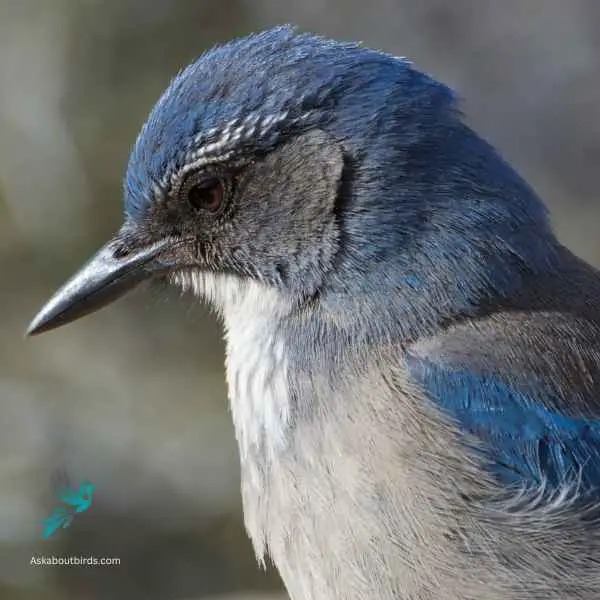

| Feature | Measurement |
|---|---|
| Scientific Name | Aphelocoma woodhouseii |
| Length | 11–12 in |
| Wingspan | 15 in |
| Weight | 80 g |
Woodhouse’s Scrub-Jay is a medium-sized bird that is found in the western part of North America. It has a blue-gray head, wings, and tail, with a brownish-gray back and a white belly. The bird’s bill is black and its eyes are dark. Woodhouse’s Scrub-Jay is known for its loud and harsh calls, which it uses to communicate with other birds in its flock.
This bird is commonly found in arid and semi-arid habitats, such as deserts, scrublands, and oak woodlands. It is an omnivore, feeding on a variety of insects, seeds, fruits, and small animals. Woodhouse’s Scrub-Jay is known for its intelligence and ability to cache food for later use. It is also a territorial bird, defending its territory from other birds and animals. Despite being a common bird, Woodhouse’s Scrub-Jay is threatened by habitat loss and fragmentation, making conservation efforts important for its survival.
Black-throated Blue Warbler

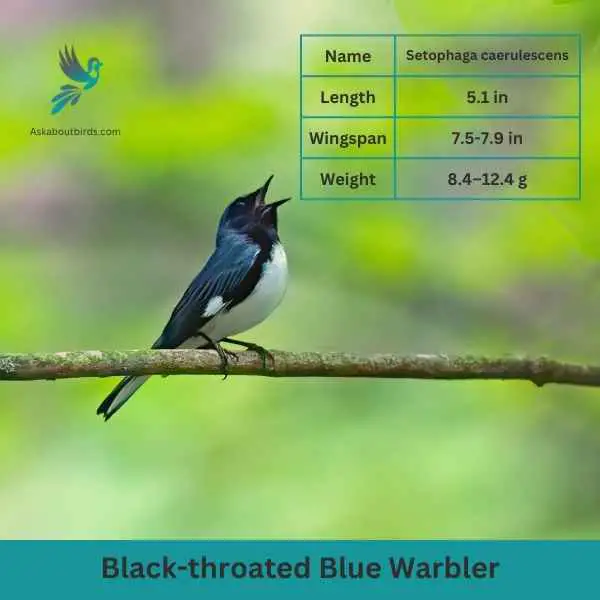
| Feature | Measurement |
|---|---|
| Scientific Name | Setophaga caerulescens |
| Length | 5.1 in |
| Wingspan | 7.5-7.9 in |
| Weight | 8.4–12.4 g |
The Black-throated Blue Warbler is a small migratory bird that breeds in the eastern United States and parts of Canada. The male Black-throated Blue Warbler displays a striking appearance with deep blue plumage on its upperparts, contrasting sharply with a black throat and a white belly. Females, on the other hand, have more muted colors, featuring grayish-olive plumage with a lighter throat.
These warblers prefer deciduous and mixed woodlands, where they forage actively for insects and spiders. They have a slender bill, which they use to extract prey from foliage and tree bark. During the breeding season, males perform courtship displays, showcasing their vibrant plumage and singing a high-pitched song to attract mates.
Black-throated Blue Warblers are known for their long-distance migration. They spend their winters in the Caribbean and Central America, where they inhabit various forested habitats. They construct cup-shaped nests in trees or shrubs, often placing them close to the ground.
Blue-winged Warbler
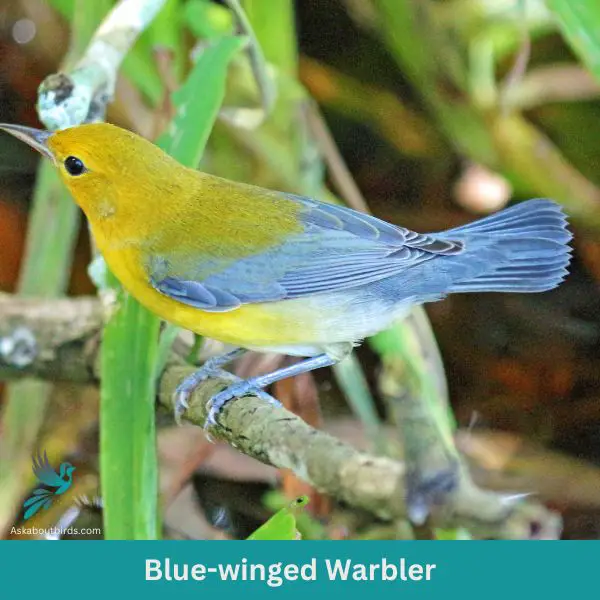
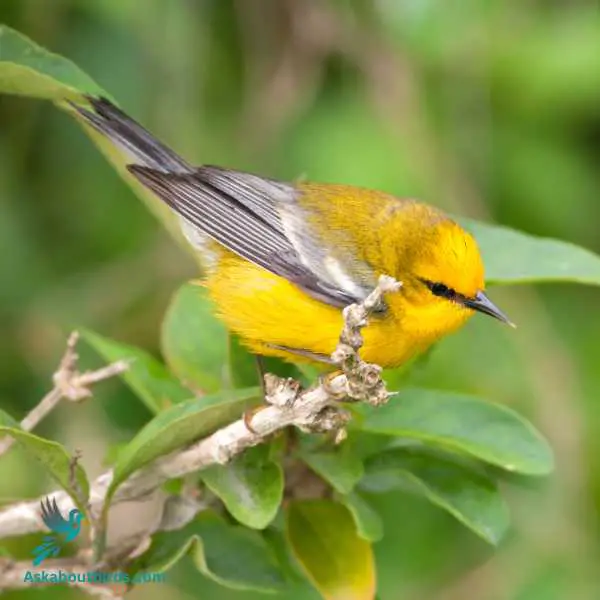
| Trait | Blue-winged Warbler |
|---|---|
| Scientific Name | Vermivora cyanoptera |
| Length | 4.3-4.7 inches |
| Wingspan | 6.7-7.5 inches |
| Weight | 0.3-0.4 ounces |
The Blue-winged Warbler is a vibrant songbird that stands out with its lemon-yellow coloring and buzzing song.
Appearance: This warbler displays a brilliant yellow body contrasted by blue-gray wings and a slim, black line through the eyes. The wings also feature two white wing bars.
Diet: The diet of the Blue-winged Warbler primarily consists of insects and spiders. They actively forage in shrubs and low trees, picking off their prey from the foliage.
Reproduction: Blue-winged Warblers build their nests on or near the ground, using grasses and other fine materials. The female lays a clutch of 4-6 eggs, which she incubates.
Where to Spot North Carolina’s Blue Birds
North Carolina is a birdwatcher’s paradise, home to a plethora of bird species, including the captivating blue birds. Here are some of the top locations in the state known for their diverse bird population:
- Pea Island National Wildlife Refuge: Located on the Outer Banks, this refuge is a vital stopover for migratory birds along the Atlantic Flyway. It offers a variety of habitats, making it a hotspot for birdwatchers.
- Pisgah National Forest: Nestled in the Appalachian Mountains, this national forest provides a diverse habitat for many bird species, including various species of blue birds, warblers, and raptors.
- Alligator River National Wildlife Refuge: This refuge is located on the mainland of Dare and Hyde Counties. It contains a variety of habitats that support a wide range of bird species.
- Cape Hatteras National Seashore: Stretching over 70 miles along the Outer Banks, this national seashore provides habitats for a variety of bird species, making it a great spot for birdwatching all year round.
- Mattamuskeet National Wildlife Refuge: Located in Hyde County, this refuge is the largest natural lake in North Carolina. It provides a winter home for migratory birds and is an excellent location for birdwatching, especially during the winter months.
| Neighboring State | Best Spots for Blue Birds |
|---|---|
| Virginia’s Blue Birds | 1. Shenandoah National Park 2. Great Dismal Swamp National Wildlife Refuge 3. Back Bay National Wildlife Refuge |
| South Carolina’s Blue Birds | 1. Congaree National Park 2. Ace Basin National Wildlife Refuge 3. Huntington Beach State Park |
| Georgia’s Blue Birds | 1. Okefenokee National Wildlife Refuge 2. Chattahoochee National Forest 3. Cumberland Island National Seashore |
| Tennessee’s Blue Birds | 1. Great Smoky Mountains National Park 2. Reelfoot Lake State Park 3. Radnor Lake State Park |
FAQs on Blue Bird Species Found in North Carolina
Can bluebirds be found year-round in North Carolina?
Yes, Eastern Bluebirds can be found year-round in North Carolina. They are permanent residents in most parts of their range, which includes the eastern half of the United States. However, during winter, some male bluebirds may migrate south to avoid extremely cold temperatures, but many remain in their breeding range year-round, including North Carolina. Providing bird feeders with sunflower seeds and live mealworms can help attract these beautiful birds to your backyard even in winter.
What can be done to prevent House Sparrows and European Starlings from taking over bluebird houses?
House Sparrows and European Starlings are invasive species that often compete with native birds like bluebirds for nesting sites. To discourage them from taking over bluebird houses, you can use a nest box with an entrance hole size of 1.5 inches in diameter, which is large enough for bluebirds but too small for starlings. Also, placing the nest box in an open area away from buildings and mature deciduous forests can make it less attractive to sparrows. Regularly monitoring the nest box and removing any sparrow nests found can also help.
What do male Indigo Buntings look like?
Male Indigo Buntings are small young birds with striking bright blue plumage during the breeding season. The intensity of the blue can appear different in varying light conditions, ranging from bright blue to almost black. They have a short, conical bill, and their wings and tail feathers are darker with black streaks. In contrast, non-breeding adult males and females have brownish-black wings and a bluish-gray tinge on their plumage.
What types of food can attract bluebirds to my backyard in North Carolina?
Bluebirds primarily consume a diet of insects, but they are also known to eat small fruits and berries. You can attract bluebirds to your backyard in North Carolina by providing a bird feeder filled with sunflower seeds and live mealworms, their particular favorites. It’s advisable to use a bluebird-specific feeder to discourage other species like house sparrows from feeding. Additionally, planting native fruit-bearing plants and trees can provide a natural food source. Keeping the feeding area clean and the food fresh will make your yard a more attractive destination for these beautiful birds.
